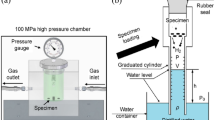Abstract
This experimental study attempts to design and develop a novel carbon-based material fabrication method that implements high voltage AC arc discharge. The carbon-based material is to be used in an electric circuit to build up a gas sensing mechanism. After applying a high AC voltage to the graphite electrodes employed in the experiment, an arc ignites between the electrodes as the gas between them is iodized. In the carbon decomposition process, the arc is employed and results in the fabricated carbon strands. Thereafter, carbon monoxide (CO2) in the atmospheric pressure is passed over the electrodes in the Pyrex glass tube chamber where the carbon strand fabrication process takes place. An increment appears in the measured current voltage (I–V) between the two sides of the carbon strand as the carrier concentration of CO2 gas is increased from 200 to 800 ppm. Support vector regression (SVR) algorithm was used for data processing with statistical analysis for errors and quality control.









Similar content being viewed by others
References
Akbari E, Ahmadi M, Yusof R, Ghadiry M, Saeidmanesh M (2013) Gas concentration effect on channel capacitance in graphene based sensors. J Comput Theor Nanosci 10(10):2449–2452
Akbari E, Buntat Z, Ahmad MH, Enzevaee A, Yousof R, Iqbal SMZ, Karimi H (2014a) Analytical calculation of sensing parameters on carbon nanotube based gas sensors. Sensors 14(3):5502–5515
Akbari E, Buntat Z, Enzevaee A, Mirazimiabarghouei SJ, Bahadoran M, Shahidi A, Nikoukar A (2014b) Correction: an analytical model and ANN simulation for carbon nanotube based ammonium gas sensors. RSC Adv 4(80):42581
Anthony M (1997) Computational learning theory. Cambridge University Press, Cambridge
Craig H, Chou C, Welhan J, Stevens C, Engelkemeir A (1988) The isotopic composition of methane in polar ice cores. Science 242(4885):1535–1539
Cristianini N, Shawe-Taylor J (2000) An introduction to support vector machines and other kernel-based learning methods. Cambridge University Press, Cambridge
Davidson EA, Ishida FY, Nepstad DC (2004) Effects of an experimental drought on soil emissions of carbon dioxide, methane, nitrous oxide, and nitric oxide in a moist tropical forest. Glob Change Biol 10(5):718–730
Gunn, S. R. (1998). Support vector machines for classification and regression. ISIS technical report 14
Gupta VK, Saleh TA (2013) Sorption of pollutants by porous carbon, carbon nanotubes and fullerene—an overview. Env Sci Pollut Res 20(5):2828–2843
Gupta VK, Ali I, Saleh TA, Nayak A, Agarwal S (2012) Chemical treatment technologies for waste-water recycling—an overview. RSC Adv 2(16):6380–6388
Gupta VK, Kumar R, Nayak A, Saleh TA, Barakat M (2013) Adsorptive removal of dyes from aqueous solution onto carbon nanotubes: a review. Adv Colloid Interface Sci 193:24–34
Huttunen JT, Alm J, Liikanen A, Juutinen S, Larmola T, Hammar T, Martikainen PJ (2003) Fluxes of methane, carbon dioxide and nitrous oxide in boreal lakes and potential anthropogenic effects on the aquatic greenhouse gas emissions. Chemosphere 52(3):609–621
Iqbal SMZ (2014) Decomposition of methane into carbonaceous material using arc discharge method. UTM thesis
Krcma F, Klohnova K, Polachova L, Horvath G (2010) Optical emission spectroscopy of abnormal glow discharge in nitrogen-methane mixtures at atmospheric pressure. Publications de l’Observatoire Astronomique de Beograd 89:371–374
Lee EK, Lee SY, Han GY, Lee BK, Lee T-J, Jun JH, Yoon KJ (2004) Catalytic decomposition of methane over carbon blacks for CO2-free hydrogen production. Carbon 42(12–13):2641–2648
Moon YK, Lee J, Lee JK, Kim TK, Kim SH (2009) Synthesis of length-controlled aerosol carbon nanotubes and their dispersion stability in aqueous solution. Langmuir 25(3):1739–1743
Müller K-R., Smola AJ, Rätsch G, Schölkopf B, Kohlmorgen J, Vapnik V. (1997). Predicting time series with support vector machines artificial neural networks—ICANN’97 (pp. 999–1004): Springer
Patel N, Bazzanella RFN, Miotello A (2011) Enhanced hydrogen production by hydrolysis of NaBH4 using “Co-B nanoparticles supported on Carbon film” catalyst synthesized by pulsed laser deposition. Elsevier 170(1):20–26
Patacsil C, Malapit G, Ramos H (2006) Optical emission spectroscopy of low temperature CVD diamond. J Plasma Fusion Res Ser 7:145–149
Schoell M (1980) The hydrogen and carbon isotopic composition of methane from natural gases of various origins. Geochim Cosmochim Acta 44(5):649–661
Smola AJ, Schölkopf B (2004) A tutorial on support vector regression. Stat Comput 14(3):199–222
Stahlbock R, Lessmann S (2004) Potential von Support Vektor Maschinen im analytischen Customer Relationship Management. Universität Hamburg, Hamburg
Stevens CM, Engelkemeir A (1988) Stable carbon isotopic composition of methane from some natural and anthropogenic sources. J Geophys Res Atmos 93(D1):725–733
Welling M (2004) Support vector regression. Department of Computer Science, University of Toronto, Toronto
Zhang J, Jin L, Li Y, Si H, Qiu B, Hu H (2013) Hierarchical porous carbon catalyst for simultaneous preparation of hydrogen and fibrous carbon by catalytic methane decomposition. Int J Hydrog Energy 38(21):8732–8740
Acknowledgments
The authors would like to thank Ministry of Higher Education (MOHE), Malaysia (Grant Vot. No. 4F382), and the Universiti Teknologi Malaysia (Grants Vot. No. 03H86 and Postdoc Grant No. 02E11) for the financial support received during the investigation.
Author information
Authors and Affiliations
Corresponding author
Rights and permissions
About this article
Cite this article
Akbari, E., Buntat, Z., Afroozeh, A. et al. Analytical investigation of CO2 sensor based on carbon strand. Int. J. Environ. Sci. Technol. 13, 339–348 (2016). https://doi.org/10.1007/s13762-015-0890-2
Received:
Revised:
Accepted:
Published:
Issue Date:
DOI: https://doi.org/10.1007/s13762-015-0890-2




